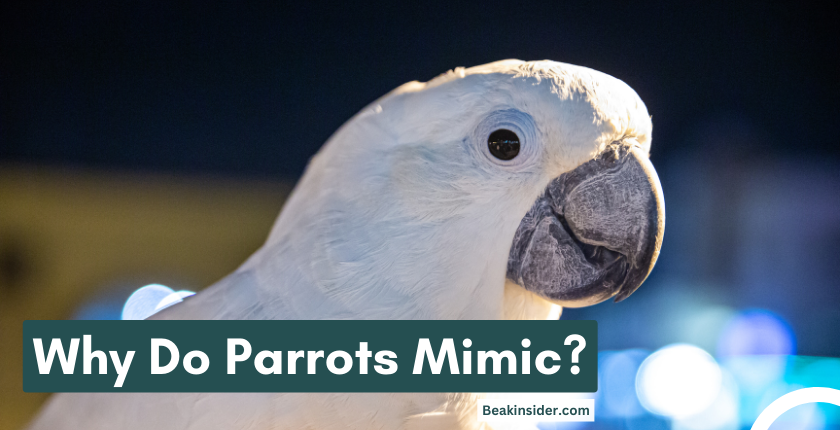Well, there is no single reason why parrots mimic. However, the three prime reasons are as follows:
- To Get The Attention Of Another Parrot
Many wild parrots mimic humans because they know they can get the attention of other parrots by doing this. When they get this attention, they let the other parrot know by talking in a language they heard from humans. So the answer to why parrots talk like humans is that when parrots hear human beings speaking, they imitate them and talk to other parrots in the same way and get their attention. - Parrots Have Excellent Memory To Remember Local Language
Another reason parrots talk like humans are their ability to memorize languages that humans speak around them. The languages the parrots mimic can help them to communicate with other parrots to get their attention or keep some male or female parrots away. - A Credit To Their Smart Brain!
A study by Plus One found that parrots can learn and copy the sounds from the brain part that was duplicated around 29 million years ago! A pair of nested vocal learning centres in this region accelerates the parrot’s ability to imitate sounds!
What Makes Parrots Talk Like Humans?
Despite the fact that parrots lack lips and teeth, they can learn words, phrases and even songs! They can do this because of keen learning and the voice box’s complex structure that helps them reproduce sounds.
The Physiology That Describes Why Parrots Talk!
Well, talking like a human is not challenging for our feathered friends! Parrots have a structure called “syrinx”. It is similar to the larynx structure, which I located at the top of the trachea in humans.
The syrinx is situated in the parrot’s chest at the bottom of the trachea. This helps parrots to speak like humans! When the parrot tries to speak, the sound passes through the throat, then the mouth and then untimely manipulated by the tongue.
Tips To Make Your Parrot Mimic Humans
1. Start with the Simple Speech
Before teaching your parrot a song, figure out if your parrot can talk. If it is already uttering words, then you are good to go. However, if not, then first try to teach her simple words and then go for the musical aspect! It will be easy for you both ☺
2. Choose an Appropriate Area for Training
The area where you train your parrot plays a vital role in the success and failure of your training sessions. Hence choose wisely!
Choose a part of the house or any other place away from the room parrot’s cage. By this, I mean choosing a place away from the area where the parrot spends most of its time. Make sure this area is free of foot traffic and distractions.
Remember that the place should have secure doors and windows to remove the risk of flying away. Also, avoid choosing a place with mirrors because your parrot friend could not resist its reflections!
3. Choose a Song that Your Parrot Loves!
Play different songs on your device to see how the parrot responds to different types of music. Is it most interesting in high-pitched songs or in songs with bass? Is it responding more to male voices than female ones?
By doing so, you can discover the artist or genre that your pet parrots enjoy most. Choose the song that it likes the most and start teaching it. It is the best technique to teach the parrot song quickly and accurately.
4. Start Slowly
Don’t rush to your parrot! Start slowly and repeat the few lines or a few words at the start. Once it starts singing these lines or words, then goes to the next. Try to hold the training session at the same time daily.
Take help from any audio editing software and create a loop of a few words or lines of the song. Play these lines over and over again to teach the parrot quickly and easily.
In this way, the parrot will recognize the sounds and tones that fit together and will try to process the types of vocalizations to reproduce the exact sound it hears!
5. Sing for Your Parrot
As you know that parrots love to mimic humans! Try to demonstrate the behaviour that parrots love to copy. In every training session, start singing the same song you want to teach. Get closer to it so that the parrot can hear you easily.
If it tries to mimic you, offer a treat for positive reinforcement. In this way, you can also create a strong bond with your pet mate!
6. Practice Often and Have Patience!
Have you heard the proverb that practice makes a man perfect? The same is the case with parrots! Parrots learn best through repetition.
Do not expect that you can train your featured mate overnight – doing so will only create frustration for you and your pet, both. Try to schedule 10-15 minutes daily to work with your parrot friend! Repetition will have various benefits, including:
- Will set up a routine that your parrot will look forward to participating in
- Will produce quick results, as setting up a schedule helps to establish consistent practice patterns
Interesting facts!
Male parrots learn to talk and mimic more rapidly than female ones. If you have a female parrot, she would still learn, but it may take longer.
Another interesting thing is that younger male parrots are easy to train than older ones. This is because they are more alert and active. The parrot’s physiology changes with time; hence, the singing, whistling, and talking behaviours change too.
Take Away
In this article, we discussed why and how parrots talk. We also shared some tips to train the parrot to speak like humans. Implement these and tell us whether they proved effective while training your pet.
Related Articles:
- Can Parrot Eat Avocado?
- Can Parrot Eat Celery?
- Can Parrot Eat Mint Leaves
- Can Parrot Eat Onion
- Can Parrot Eat Radish?

I’m Amna, and I absolutely adore birds, especially parrots. I’ve been immersed in the world of these colorful feathered friends for over 10 years. While I’m not a bird doctor, I’ve gathered a wealth of knowledge on how to care for and understand them.
My experiences extend to various bird species like parrots, macaws, cockatoos, canaries, and finches. In addition to my personal adventures with birds, I’ve dedicated time to volunteering at a local bird rehabilitation center.
My true passion lies in sharing what I know about parrots and birds with you. Through my articles, I aim to share the information you need to provide the very best care for your avian companions. So, let’s embark on this journey together and make your feathered friends’ lives as joyful and healthy as possible!


The point of view of your article has taught me a lot, and I already know how to improve the paper on gate.oi, thank you. https://www.gate.io/ar/signup/XwNAU